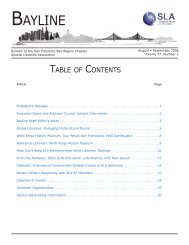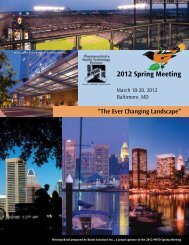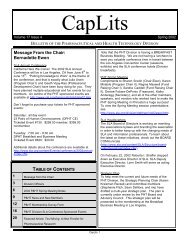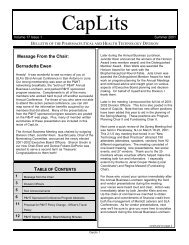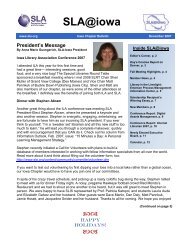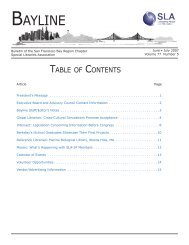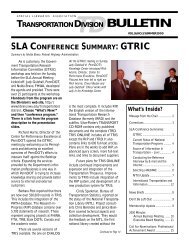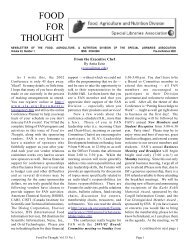Education Libraries - Special Libraries Association
Education Libraries - Special Libraries Association
Education Libraries - Special Libraries Association
You also want an ePaper? Increase the reach of your titles
YUMPU automatically turns print PDFs into web optimized ePapers that Google loves.
Interview with Tamara Moats, Speaker on Visual Thinking and Use of Art Data<br />
By Cybèle Elaine Werts, Article Editor of <strong>Education</strong> <strong>Libraries</strong><br />
NOTE: I met Tamara Moats when she was on a panel at the <strong>Special</strong> <strong>Libraries</strong> Conference<br />
in Seattle, WA this June. Her lecture/demonstration was entitled Visual Thinking and<br />
Use of Art Data. As I knew of our upcoming issue on digital, information, and visual<br />
literacy, I contacted her right away for an interview as a special addition to this issue.<br />
Visual & Media<br />
Literacy<br />
Tamara Moats was curator of education at the University of Washington's Henry Art Gallery for nineteen<br />
years where she organized programs for all ages, developed the museum’s teaching methods, and wrote<br />
extensive curricula. She now teaches art history at the Bush School Upper School and the Cornish College of<br />
the Arts, and visual thinking at the University of Washington Medical School. Moats holds a BA degree in<br />
art history from the University of Puget Sound and an MA in Asian Studies from the Claremont Graduate<br />
School.<br />
To help explain Tamara’s work, I’ve included<br />
this explanation of Visual Thinking:<br />
Visual Thinking is an inquiry-based method of<br />
teaching with original art works. It empowers<br />
viewers to trust their own observations,<br />
interpretations, and ideas about works of art.<br />
Facilitators ask students to articulate their<br />
responses and to find evidence to support opinions<br />
and reasoning. Student response drives all<br />
observations; the facilitator does not direct the<br />
discussion.<br />
Visual Thinking focuses on viewer response and<br />
interest. Using dialogue posed by the teacher or<br />
exhibition guide, Visual Thinking<br />
allows the viewer to guide the inquiry.<br />
In this sense it is not informationbased,<br />
but information is woven into<br />
the discussion as it is asked for. The<br />
process progresses from narrative<br />
artwork to more complex ones,<br />
exploring images that relate to but play<br />
off of each other. Questioning begins<br />
very simply by asking students “What<br />
is going in this artwork?” and allowing<br />
the discussion to follow a logical but<br />
creative progression. The idea is to<br />
reveal information about the work<br />
throughout the discussion, and guide<br />
the questioning to places that<br />
illuminate the artwork. This includes<br />
exploring composition, subject matter,<br />
medium, and artist, but the stress is<br />
placed on discovering meaning and<br />
deeper ideas. Visual Thinking builds critical and<br />
creative thinking skills that enhance the whole of<br />
the aesthetic experience.<br />
One of the things that strikes me first about<br />
your unusual vocation is that most viewers<br />
probably say that they don’t know anything<br />
about art, and therefore their thoughts and<br />
observations about it cannot possibly have<br />
value. How do you counter this widespread idea<br />
that only experts can understand art?<br />
My belief is that if under open and welcoming<br />
circumstances, most people cannot help but give<br />
their responses to an artwork, and if the works are<br />
well chosen, find something to<br />
talk about. The adult audience is<br />
a little more tricky, since older<br />
people usually do want to get<br />
some background before<br />
responding, but I have found that<br />
with the right, very brief,<br />
introduction, I can ask a question<br />
that the audience wants to<br />
answer. As for children, it is the<br />
reverse: all kids want to tell you<br />
what they see before getting any<br />
information on an artwork. They<br />
need little encouragement.<br />
<strong>Education</strong> <strong>Libraries</strong>, Volume 31, No. 2, Winter 2008 39



